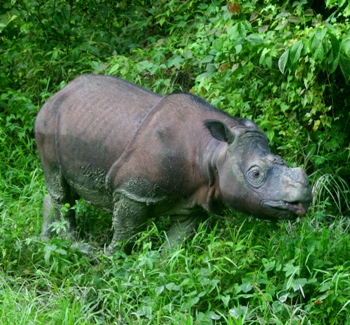Rhino conservationists’ hopes were dampened today by news that Ratu, a female Sumatran rhino, had lost her pregnancy. Just months after the announcement of the pregnancy—the first at Indonesia’s Sumatran Rhino Sanctuary in Way Kambas National Park—Ratu lost the embryo. Still, say conservationists, the very fact that Ratu became pregnant at all should keep hope alive for the beleaguered species.
“This is not unusual for a rhino’s first pregnancy,” explains Dr. Susie Ellis, executive director of the International Rhino Foundation (IRF). “While we are saddened by this loss, the fact that we achieved a pregnancy confirms that our work with the Sumatran rhino breeding program is progressing. Ratu and Andalas [the father] are healthy and have produced one pregnancy, so we are optimistic that success will soon be achieved.”
 A Bornean rhino, a subspecies of the Sumatran rhino, in captivity in Borneo. Photo by: Jeremy Hance. |
Sumatran rhinos are considered one of the world’s most threatened mammals. Vast deforestation in Malaysia and Indonesia—still ongoing—as well as targeting by poachers, has caused the Sumatran rhino to vanish entirely from much of their former range and hang-on by a thread in others. Today, it is estimated that only 200 Sumatran rhinos survive in the wild with 10 individuals in captivity.
In addition, Sumatran rhinos are notoriously difficult to breed successfully in captivity. Last year, Emi, the world’s only Sumatran rhino to successfully give birth in over a century died at the Cincinnati Zoo in the US. Emi, herself, had five failed pregnancies before she gave birth to Andalas, who was transported to Indonesia to breed with Ratu and other females. Indonesia’s Sumatran Rhino Sanctuary hopes it can use the expertise learned by Emi’s eventual successes to be the next to produce Sumatran rhino offspring.
“Our staff is disappointed, but the fact that we did achieve a pregnancy reconfirms our commitment to helping Ratu and Andalas succeed,” said Dr. Dedi Candra, the sanctuary’s animal collection coordinator. “We continue to learn more about the Sumatran rhino’s breeding and gestation habits, which will help us manage Ratu’s next pregnancy.”
The last surviving member of the genus Dicerorhinus, Sumatran rhinos are distinguished by being the world’s smallest rhino and the only one to be nearly covered in a coat of reddish-brown hair. The species is also thought to be the most closely-related living relatives to the wooly rhinoceros, which roamed Europe and Russia until 10,000 years ago.
“Saving this species is a balancing act. We must care for the wild population and also try to breed as many animals as possible in captivity in order to save it,” says Ellis, who notes that no Sumatran rhino has been poached in five years due at least in part to stepping up protection of these vanishing jungle behemoths.
Video of Emi’s third and final infant soon after birth.
Related articles
Pregnancy gives new hope for rhino on-the-brink of extinction

(02/18/2010) Though they grew up world’s apart, Sumatran rhinos Ratu and Andalas have given conservationists new-found hope for saving the embattled species. The rhino couple is expecting, according to the Sumatran Rhino Sanctuary at Way Kambas, Indonesia. One of the world’s most endangered big mammals, Sumatran rhinos are unique due to their hairy bodies and small size (at least compared to other rhinos). The last surviving members of the genus Dicerorhinus, only 200 Sumatran rhinos are estimated to survive in the wild. Ratu’s pregnancy holds special significance for a number of reasons. It is the first pregnancy at the Sumatran Rhino Sanctuary; it will be both Ratu’s and Andalas’ first calf; it is also the first pregnancy in captivity since Andalas’ mother Emi—the only Sumatran rhino to successfully give birth in captivity for 112 years—passed away last fall.
Face-to-face with what may be the last of the world’s smallest rhino, the Bornean rhinoceros

(12/01/2009) Nothing can really prepare a person for coming face-to-face with what may be the last of a species. I had known for a week that I would be fortunate enough to meet Tam. I’d heard stories of his gentle demeanor, discussed his current situation with experts, and read everything I could find about this surprising individual. But still, walking up to the pen where Tam stood contentedly pulling leaves from the hands of a local ranger, hearing him snort and whistle, watching as he rattled the bars with his blunted horn, I felt like I was walking into a place I wasn’t meant to be. As though I was treading on his, Tam’s space: entering into a cool deep forest where mud wallows and shadows still linger. This was Tam’s world; or at least it should be.
World’s only Sumatran rhino to give birth in captivity dies at Cincinnati Zoo
(09/10/2009) Emi, the world’s only Sumatran rhino to give birth in captivity, died on Saturday at the Cincinnati zoo. She successfully gave birth to three offspring, one of which has been released back into the wild in Indonesia.